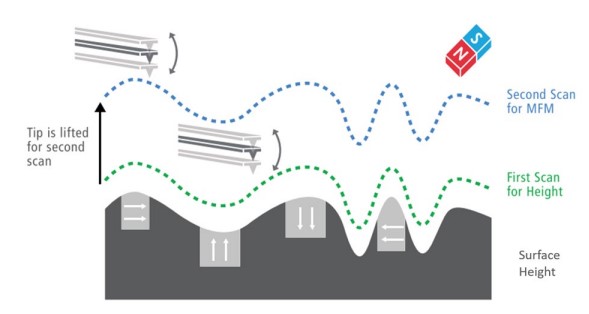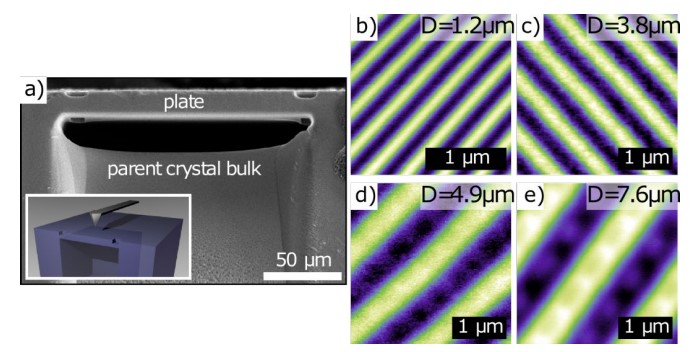MFM on Mn1.4PtSn: Investigating magnetic hosts for Anti-Skyrmions
B. E. Zuniga Cespedes1,2, A. S. Sukhanov1,3, P. Milde1, L. M. Eng1,4, I. Hermes5, A. Klasen5
1 Institute of Applied Physics, Technische Universität Dresden, D-01062 Dresden, Germany
2 Max Planck Institute for Chemical Physics of Solids, D-01187 Dresden, Germany
3 Institut für Festkörper- und Materialphysik, TU Dresden, D-01062 Dresden, Germany
4 ct.qmat: Dresden-Würzburg Cluster of Excellence – EXC 2147, TU Dresden, 01062 Dresden, Germany
5 Park Systems Europe GmbH
Abstract:
Skyrmions and antiskyrmions are quasiparticles based on topological spin arrangements. Due to their small size and high stability, they are studied for applications in the field of spintronics, including high density data storage and transfer, as well as for neuromorphic computing.1,2
This Application Note bases on the publications of Sukhanov et al. “Anisotropic fractal magnetic domain pattern in bulk Mn1.4PtSn”, Phys. Rev. B 102, 174447 (2020), https://doi.org/10.1103/PhysRevB.102.174447, and Zuniga Cespedes et al. “Critical sample aspect ratio and magnetic field dependence for antiskyrmion formation in Mn1.4PtSn single crystals”, Phys. Rev. B 103, 184411 (2021), https://doi.org/10.1103/PhysRevB.103.184411, that focus on the effect of geometrical confinement on the antiskyrmion formation in the tetragonal Heusler compound Mn1.4PtSn.3,4 Via magnetic force microscopy (MFM), the researchers were able to resolve a thickness dependent formation of either a fractal ferromagnetic domain pattern or a spin helix pattern serving as the template for the nucleation of antiskyrmions.
Introduction:
In an ever-growing digitalized world, recent estimations suggest that we already produce 2.5⋅1018 bytes of data per single day.5 This staggering amount of data calls for new data storage technologies to stem the tide of expanding information.
Here, skyrmions and antiskyrmions might provide novel solutions for smaller and faster data storage with improved energy efficiency.6 Skyrmions and antiskyrmions are topological spin structures arranged in small vortices, that act as quasiparticles in the magnetic texture of certain host materials.7
Their size may vary between 100 µm and 1 nm.8 Due to their size, stability and response to external electric or magnetic fields, the application of skyrmions and antiskyrmions in spintronics is studied for high density data storage and transfer, as well as for neuromorphic computing.1,2 Antiskyrmions have been observed in some tetragonal Heusler compounds, including also Mn1.4PtSn. To locally resolve magnetic patterns on these compounds and to investigate their dependence on the sample geometry, an imaging method with nanoscale spatial resolution and high magnetic sensitivity is required. Here, magnetic force microscopy (MFM) available on all Park Systems NX research Atomic Force microscopes (AFM), enables the simultaneous real-space imaging of both surface topography and magnetic structure.
MFM utilizes magnetized AFM cantilevers that allow imaging of magnetic nanostructures due to their discrimination and sensitivity towards van der Waals (vdW) and magnetic tip-sample interactions. Both vdW and magnetic forces are measured via changes in the oscillation properties of the cantilever, being reflected either in changes of the oscillation amplitude, resonance frequency or phase. To disentangle vdW from magnetic contributions, MFM uses the different distance dependence of van der Waals and magnetic force. At close proximity, van der Waals interactions dominate the tip-sample force, which allows to image sample topography with high accuracy. At larger distances of 50-500 nm, the short-ranged van der Waals interactions become minimal and magnetic forces govern the tip-sample interaction. Accordingly, MFM traces each scan line twice: the first run is used to image the sample topography, while in the second run the magnetic texture information of the sample is recorded (Figure 1). To keep the tip-sample distance constant during the second pass, the cantilever follows the previously recorded topographic profile, thus always recording magnetic interactions at the same nominal distance. The resulting phase shift of the oscillation provides information on the local magnetic polarization of the magnetic moment, and thereby resolves ferromagnetic domain patterns such as the antiskyrmion lattice that is present in the sample investigated here.

Figure 1: Dual pass MFM mode with the detection of the sample topography in the first pass and the detection of the magnetic structure in the second pass.9
Experimental:
The magnetic properties of a single crystal and thin lamellas of Mn1.4PtSn were investigated using a Park Systems NX10 AFM at ambient conditions. The sample was mounted on a non-magnetic sample holder to avoid magnetic crosstalk. For MFM, a cantilever with a magnetic coating (PPP-MFMR, Nanosensors) was magnetized prior to operation and used for all experiments. MFM measurements were conducted in dual-pass scanning mode (Figure 1). In the first pass, the topography was imaged in Park’s True Non-ContactTM Mode. Subsequently, the cantilever was lifted by 100 – 150 nm and the magnetic stray field was detected via cantilever oscillation demodulation, while retracing the topographic profile (see Figure 1).
Single crystals of Mn1.4PtSn were investigated that were grown by the flux method.10 Properly-grown crystals were polished along the ab plane using a focused xenon ion beam in order to create smooth surfaces, and then imaged in Figure 2.4 For investigating the thickness dependence on magnetization, suspended lamellae of different thicknesses that range from 400 nm to 10 µm were created by cutting a 100 × 100 µm² groove into the side of the single crystal (see Figure 3a).3
Results and Discussion:
Previous studies have proven the existence of antiskyrmions in Mn1.4PtSn, at least in ultrathin layers thereof. 10,11 However, the room temperature MFM measurements on the polished ab plane of a bulk Mn1.4PtSn single crystal reveal no antiskyrmion lattice; instead, the formation of a fractal ferromagnetic domain pattern made up of lamellar stripes with widths up to 3 µm is witnessed (Figure 2b). Further magnifications in Figure 2c and 2d display additional smaller nested domains of an arrowhead shape and opposite orientation around domain walls, thus, introducing chirality. This chirality around domain walls is indicative of the presence of the Dzyaloshinski-Moriya interaction (DMI) – an anisotropic magnetic exchange interaction, fundamental for the formation of skyrmions and antiskyrmions. The study by Sukhanov et al. thus shows that bulk Mn1.4PtSn single crystals favor a ferromagnetic ground state that is dominated by lamellar stripe pattern, rather than antiskyrmion lattice formation.4

Figure 2: a) Sample topography b)-d) Fractal ferromagnetic domain pattern in the MFM phase of bulk crystals of Mn1.4PtSn.4
The subsequent study by Zuniga Cespedes et al. used the MFM to resolve the thickness-dependent transition from the fractal ferromagnetic domain structure in bulk Mn1.4PtSn, to a simple pattern with single rows of nested domains, as the thickness decreased towards 4.4 µm (Figure 3b-e). Below the threshold thickness at 4.4 µm, the nested domains disappeared to form uniform sinusoidal stripes that are the building blocks for nucleating spin helices (Figure 3b-e). This magnetic pattern based on spin helices may act as the prototype for antiskyrmion lattice formation when magnetic fields are applied.3

Figure 3: a) Mn1.4PtSn single crystal with groove cut along the ab plane to create a suspended thin plate with defined thickness. b- e) Magnetic patterns at varying plate thicknesses with the appearance of a sinusoidal spin helices pattern.3
Conclusion:
In conclusion, room temperature MFM measurements on the Park Systems NX10 AFM revealed that, instead of antiskyrmions, bulk Mn1.4PtSn features anisotropic fractal ferromagnetic domains, indicating the presence of DMI as the prerequisite for antiskyrmion formation.4 By decreasing the layer thickness of Mn1.4PtSn to below 4.4 µm, a sinusoidal stripe pattern appears that originates from the nucleation of spin helices caused by DMI. Under applied magnetic fields this pattern then acts as the template structure for antiskyrmion nucleation.3
References:
1. Zhang, X. et al. Skyrmion-electronics: writing, deleting, reading and processing magnetic skyrmions toward spintronic applications. J. Phys. Condens. Matter 32, 143001 (2020).
2. Büttner, F., Lemesh, I. & Beach, G. S. D. Theory of isolated magnetic skyrmions: From fundamentals to room temperature applications. Sci. Rep. 8, 4464 (2018).
3. Zuniga Cespedes, B. E., Vir, P., Milde, P., Felser, C. & Eng, L. M. Critical sample aspect ratio and magnetic field dependence for antiskyrmion formation in Mn1.4PtSn single crystals. Phys. Rev. B 103, 1–7 (2021).
4. Sukhanov, A. S. et al. Anisotropic fractal magnetic domain pattern in bulk Mn1.4PtSn. Phys. Rev. B 102, 1–9 (2020).
5. Price, D. How much Data is produced every day? https://cloudtweaks.com/2015/03/how-much-data-is-produced-every-day/.
6. Karube, K. et al. Room-temperature antiskyrmions and sawtooth surface textures in a non-centrosymmetric magnet with S4 symmetry. Nat. Mater. 20, (2021).
7. Koshibae, W. & Nagaosa, N. Theory of antiskyrmions in magnets. Nat. Commun. 7, (2016).
8. Nagaosa, N. & Tokura, Y. Topological properties and dynamics of. Nat. Publ. Gr. 8, 899–911 (2013).
9. Pineda, J. P., Newcomb, C., Pascual, G., Kim, B. & Lee, K. Detection of Magnetization Reversal in Magnetic Patterned Array using Magnetic Force Microscopy. Park Syst. Appl. Note 17 (2017).
10. Vir, P. et al. Tetragonal superstructure of the antiskyrmion hosting Heusler compound Mn1. 4PtSn. Chem. Mater. 31, 5876–5880 (2019).
11. Saha, R. et al. Intrinsic stability of magnetic anti-skyrmions in the tetragonal inverse Heusler compound Mn 1.4 Pt 0.9 Pd 0.1 Sn. Nat. Commun. 10, 1–7 (2019).




